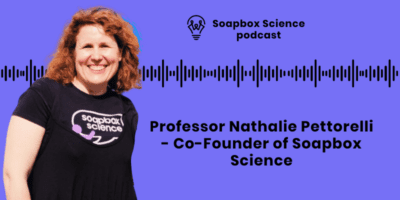Dr Gitanjali Poddar is a Postdoctoral Researcher in Particle Physics at Queen Mary University of London. In her Soapbox Science talk at Soapbox Science in London on Saturday 25th May 2024, she introduced her research, which combines fundamental theory, statistical data analysis, software development, and hardware engineering. The title of her talk was “Large Hadron Collider: The Fellowship of the Ring”

“My research combines fundamental theory, statistical data analysis, software development, and hardware engineering. The dynamic and interdisciplinary nature of this research is what initially captivated me and continues to inspire my work.”
From India to Scotland, Switzerland and France
Starting my academic journey in India, I developed a strong interest in physics, which inspired me to pursue a bachelor’s degree in Scotland. During my undergraduate studies, I studied various areas of physics, from understanding how big things move in classical mechanics to exploring the behaviour of tiny particles in modern quantum mechanics. These experiences helped me realise that I’m most passionate about experimental particle physics. So, for my final year project, I investigated the properties of cosmic particles in a laboratory setting.

Following my bachelor’s degree, I pursued a master’s degree in Switzerland, where I focused on particle physics theory and gained practical experience through projects at CERN, the European Organisation for Nuclear Research. CERN is home to the Large Hadron Collider (LHC) is the world’s largest and most powerful particle accelerator. It consists of a circular tunnel about 27 kilometres (17 miles) in circumference, buried underground. The LHC accelerates particles, such as protons and lead ions, to very high speeds and then smashes them together. Scientists study these collisions to investigate the fundamental properties of matter and the forces that govern the universe.
These experiences reinforced my interest in experimental particle physics and honed my skills in data analysis, machine learning, and scientific communication. Continuing my academic journey, I pursued a PhD in France, where I delved further into the analysis of data from the Large Hadron Collider at CERN to search for new physics and contributed to upgrade studies of detector calibration boards.
London calling
Now, as a postdoctoral researcher in England, I specialise in precision measurements of fundamental parameters of particle physics theory using LHC data, leveraging my expertise gained throughout my academic journey across multiple countries. My days are filled with diverse tasks vital to our research progress, ranging from reviewing scientific papers to conducting data analysis and mentoring students.
Working with colleagues in science ignites creativity and helps problem-solving by leveraging diverse perspectives, collaborative brainstorming, shared knowledge and resources, feedback and critique, motivation, and cross-disciplinary collaboration, while multiple cups of tea keep me refreshed and focused throughout the day!

Enhancing our understanding of the fundamental components of the universe
The research conducted at the LHC holds immense potential for diverse future applications. Exploring higher energy collisions enhances our understanding of the fundamental components of the universe and adds to the body of scientific knowledge. Even more excitingly, the technologies developed for the LHC could find applications in medical imaging, radiation therapy, materials science, and cleaner energy solutions.
The vast amounts of amount of data from the LHC push forward computing, AI, and data analysis, and its educational programmes encourage science learning and global teamwork.
Making change, having fun
I chose to be a Soapbox Science speaker to promote diversity in STEM while also nurturing my personal development through science communication and outreach. It’s a deeply fulfilling opportunity to share my passion for science, contribute to positive change within the scientific community, and, importantly, to have a lot of fun in the process!
My talk took place on Saturday 25th May at the Southbank, London. In my presentation titled “Large Hadron Collider: Fellowship of the Ring”, I delved into the physics investigated at the LHC, focusing on how high-energy protons collide to explore fundamental particles and theories. I brought these concepts to life with a creative demonstration using LEGO.
Interacting with the public was incredibly rewarding because the audience was enthusiastic, showing a genuine interest in science and creating a dynamic exchange of knowledge and ideas. I was thrilled by the response I received from the public, with people of all ages getting involved and asking some fascinating questions that really got me thinking!
Additionally, I’m always eager to share my research and engage in discussions. Feel free to reach out via email at g.poddar@qmul.ac.uk.
Header image: © Yi Ker Gan





